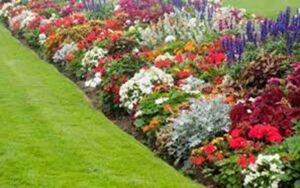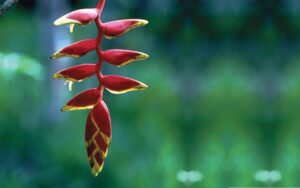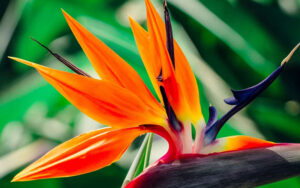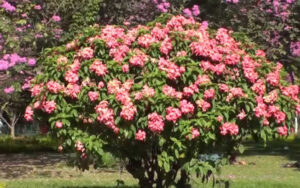Kalanchoe
Brilliant, bold and beautiful often scarlet blooms with thick green foliage of Kalanchoe plant often catches our sight in chilling weather and as it blooms it brings numerous new hopes and happiness as new year marks upon.
Kalanchoe is a popular succulent pot plant owing to its vibrant flowering habit and attractive foliage where some species can tolerate shady conditions and thus can be grown in indoors. Long-lasting colorful flowers and succulent foliage consisting of toothed thick waxy leaves, thick branched stems and cymose inflorescences are interesting features of it. Commonly, it is known with different names like Katy, Widow’s thrill, florist kalanchoe,Chandelier Plant, Devils Backbone, Mother-In-Law-Plant, Mother of Millions, Mother of Thousands, etc. It belongs to Crassulaceae (stonecrop family) and is native to Madagascar and tropical Africa.It was introduced in 1932 by Robert Blossfeld, a German hybridizer, hence, the species K.blossfeldiana has been named after him. There are around 120 species in Kalanchoe having variation in colour, multipetalous flower forms, with variation in foliage colour and growth habit.
Kalanchoes as pot plants can be very well displayed in balconies, in verandas as well as in home gardens. They can be very well used in rockeries with other succulents as well as in dish gardens in indoors. It tolerates drought condition and can even grow well in low light condition
Species
Commonly known as florist’s kalanchoe owing to colourful flowers which has good longevity is the K. blossfeldiana. It is often seen in scarlet colour inflorescence but new varieties is different colours like white, yellow, pink shades are also available. The species, valued for their unusual foliage, include the panda plant (Kalanchoe tomentosa); penwiper plant (K. marmorata); velvet leaf, or felt bush (K. beharensis) and devil’s backbone or mother of thousands (K. daigremontiana).

- Bryophyllums (Mother of millions) It propagates in profuse as baby plants from fallen leaves at the edges that root.Usually it is not that showy.
- Fuzzies (Panda Plant) These are covered with pubescence-short hairs on the leaves. The leaves show light greying colour with brown edges. These look beautiful in indoor dish garden or indoor pot plant. These areKalanchoetomentosa
- Tree like (velvet elephant ear) It is also known as Velvet Leaf plant, Felt Bush. Kalanchoe beharensisis the species that can grow so tall like a tree but is very slow in growth and flowers rarely. These grow tall upto 6 m and found atMadagaskar.
- Paddles These show overlapping leaves in oval shape with bright red colour. Kalanchoeluciae. These are highly prized.
- Profuse flowering types (Floriferous) These are bright flowering types. Kalanchoe blossfeldiana and Kalanchoe calandivas are the highly popular owing to vibrant flower colours. Spreading types like Kalanchoe fedschenkoi have pastel leaves and masses of coral flowers.
- Tropical These are the types having large and thinleaves but are highly sensitive to climate and sun exposure. Kalanchoe marmorata, Kalanchoe gastonis-bonnieri, Kalanchoe prolifera (box bloom) and Kalanchoe synsepala. These are often referred as “walking kalanchoes”. These have arrowhead or enlongated-oval leaves that produce baby plants at tips of flower stems.
- Unsual types (Rarities) Kalanchoe humilis and Kalanchoe rhombopilosa are highly priced and rare species.
Flower and foliage Description
Flowers are unscented, salverform (tubular), and fleshy and seen in different colours Corolla is 4-lobed and fleshy. Calyx is 4-lobed, fleshy, and small. Flowers have 8 stamens in 2 whorls of 4. Flowers are vibrant in colour in ranges of red to yellow, pink to white and have a sticky gland. Some hang in a bell-like way. Inflorescence is a panicle of cymes or an umbel. Double-flowered cultivars are available. Leaf colours varies from green, grey to silver, pink to lavender, reddish burgundy and with or without variegation. Leaves are fleshy, smooth or velvety and waxy and are opposite, simple, fleshy, succulent, and flattened. Some species have toothed leaves while some have scalloped leaf margin while others show smooth and sharp edges. Leaf colour variegation changes as per the availability of light in some species. Some species show viviparous nature and form plantlets at leaf edges.
Climate
Kalanchoes thrive well in mild climate and loves coastal region. Extreme climate and freezing temperature, is difficult for kalanchoes. Frost is very harmful and a long spell of frost often kills the plant. It comes to flowering when night temperature dips below 150 C.
Propagation Method
It is usually propagated through leaf and stem cuttings.
Pot Media Management
Potting mix for kalanchoe should be with good drainage as they are susceptible to rot under water logged conditions. Red soil and sand mixure (3:1) is often preferred with some added organic mix. However, a media comprising of cocopeat or peatmoss, perlite or Styrofoam along with vermicompost (v/v3:1:1) is found suitable for growing kalanchoe.
Irrigation and Nutrition Management
Well balanced N.P.K fertilizers along with micronutrients should be applied regularly for fast growth and good flowering. The plants respond dramatically to a regular diet of fertilizer. The best way is to apply relatively low nitrogen, moderate phosphorus and high potassium and apply in fractions with watering during the growing season. The plants are sensitive to nitrogen, responding to an excess with rampant vegetative growth. Frequency of fertigation is important rather than quantity of fertilizers to be added. Normally in soilless media according the pot volume, it should be watered twice a week. In the initial stage of plant growth, requirement of nitrogen and potassium is higher. Providing nitrogen in nitrate form is very important in order to avoid lanky growth of the plant. Therefore, calcium nitrate and potassium nitrate which are major source of nitrate nitrogen should be supplied through fertigation in initial stages of plant growth. Water used for fertigation should have low EC i.e 0.1 to 0.2 Ms/cm. EC of the fertigation water should not exceed 1.00 Ms/cm and pH should be 5.5 to 6.5. Nutrient concentration in water should not exceed 1000 ppm. PH and EC of the leachates from the media should also be checked at regular interval and if it exceeds 2.00 Ms/cm, it can be reduced by flushing or watering the media with plain water having EC 0.1-0.2 Ms/cm. Root rot may occur or is aggravated with excessive watering. Hence, restricted watering, well drained media and drenching with fungicides can control these problems.
Pinching
Pinching in initial stage atleast two to three times when the plant is in vegetative stage is an important practice to maintain plant dwarfness, to impart bushy appearance and plant compactness. Use of plant growth retardants like daminozide, cycocel, etc can be done to induce further dwarfness, smaller leaves and compactness





















